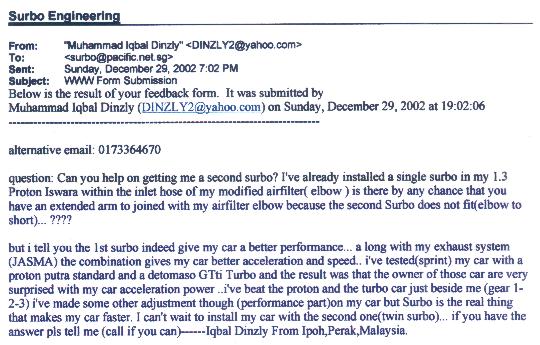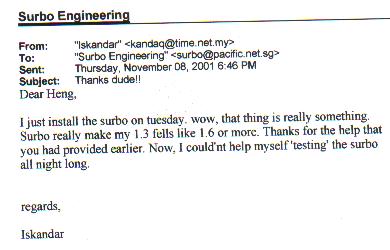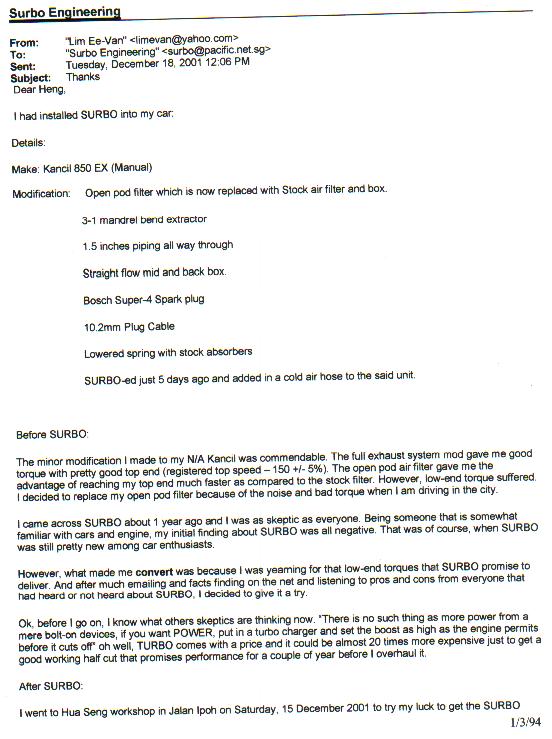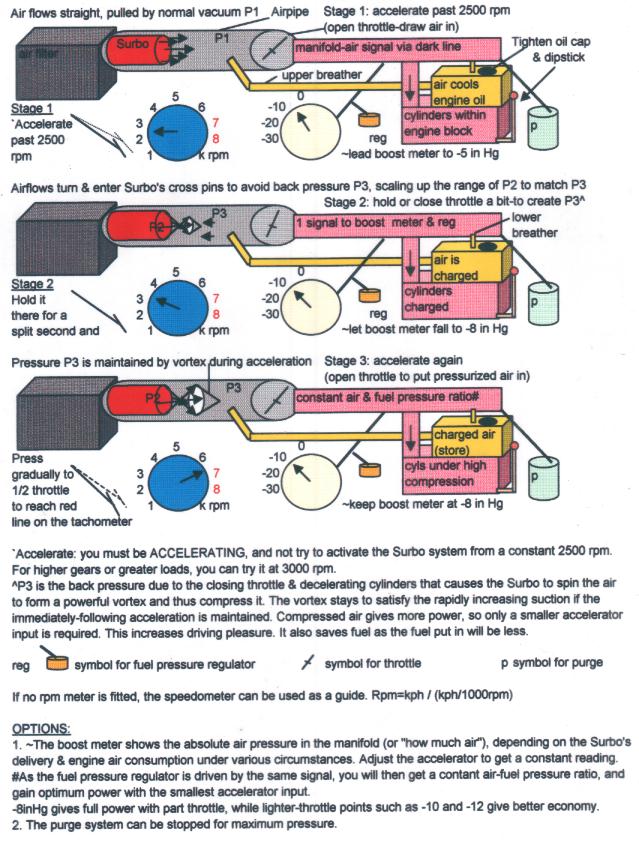
Apr 15, 2009
WHEN YOU'LL NEED THE SURBO
1. More torque. Torque means instant twist power. The engine with Surbo on can accelerate briskly and sustain the acceleration to red line or beyond, all on half throttle or less. That means easier pickup, and fuel savings because you will press less on average.
2. Higher power peak. If your car starts slowing down the moment you hit 4000 rpm, you know it's time to restore the power. The Surbo takes your engine back to red line easily and puts back some 50% of existing acceleration power based on rpm, assuming a red line of 6000 rpm. It also means that instead of travelling 40 metres, you travel 60 metres in about the same time taken, given the quick flick of the tachometer when the Surbo is activated. That puts you a clear 20 metres ahead, and up the gears you will pull even further away from other cars as they start to slow down once they get to third gear. You could never be accused of holding up traffic!
3. Hill climbing. Do you have to tackle these often? Steep car parks? Well, the Surbo has a great affinity for hills. Just going up the incline, activate the Surbo to race up the hill. More..
4. Airconditioner on all the time? Saps a lot of power, doesn't it? Well, with the Surbo, the aircon load becomes less of a problem due to the power assistance.
5. Carrying a load meant for an MPV? Sending half a dozen people home? The Surbo diminishes the load and gives your car added muscle. It pulls and lugs, and of course you can have the aircon on as well.
6. Fast driving on long hauls. The cross-country, few-hour long trips on which the priority is getting to the destination ASAP, and the road seems too straight for you to keep to sane speeds anyway. You'll find that you may get to your rated top speed with less than full throttle. (That means an increase in BHP as BHP has a direct relation with top speed, while acceleration has a closer relation with torque). Or you'll be travelling constantly, say at 150kph with about half throttle. The increase in the top end will be especially noticeable if your car has accumulated a lot of mileage and needed a lot of coaxing to run so fast. If your foot is tired, you can ease off the accelerator a little, but your car will keep moving (more than with no Surbo) as this raises the back pressure at the Surbo and pushes the car .
7. Overtaking. Just prepare the Surbo for temporary steroids, muscling in clearly with a tingling throttle so you know when to stick your car out. Then it's a quick shove, relentless pulling to red line, repeating in the next gear if necessary, cutting in and driving normally till you need the boost again.
8. Fuel saving. Since cruising speed is a function of the top speed, and top speed has been raised with the Surbo, the engine needs to exert less effort on expressways. The result is fuel saved. Our customer feedback shows that the maximum-economy speed gets stretched from the usual 90 kph to 110 or 120 kph. e.g.. A Surbo Civic ESi will do 12 km/l in town but 17 km/l at 110 kph.
Is that like a normal day in your driving? Or how fast you'd like your car to be? If it is, you might like to check out the Surbo and see how marvelous and useful it is with its power on demand. Try it!
IMPROVED PERFORMANCE
The following cars have been recorded at speeds higher than their original top speeds:
| Make Of Car | Original Top Speed | Highest Speed With Surbo | Achieved In Gear | Remarks |
| '01 Citroen Berlingo 1.9 Diesel | 130 kph | 140+ kph | 4th or 5th | With aircon on |
| '89 Honda Civic 1.3 GL | 170 kph | 185 kph | 5 | |
| '97 Mitsubishi Lancer MR 1.6 | 210 kph | 220 kph | 180 kph in 3rd | Richard Wong |
| '93 Opel Vectra 1.6 | 190 kph | 205 kph | ||
| '98 Proton Wira 1.6A | 160 kph | 180 kph | 4 | K H Tan |
| Peugeot 106 | 115 mph | 118+ mph | 5 | UK-Cruise |
| '89 Peugeot 405 1.6 | 180 kph | 188 kph | 5 | 3/4 throttle only |
| Proton Putra 1.8 | 208 kph | 215 kph | 5 | limited by gearbox |
| '96 Rover 416 HHR | 190 kph | 220 kph | 5 | |
| '95 Skoda Felicia 1.4 | 96 mph | 100 mph | 5 | Peter Allen |
| Toyota Starlet 1.3 16v turbo | 120 kph | 150 kph | 3 | Chris of Kota Kinabalu |
| Toyota Starlet '89 1.0 | 150 kph | 170 kph+ | 5 |
The following cars have improved acceleration times:
| Make Of Car | 0-100 kph Before Surbo | 0-100 kph With Surbo | Achieved In Gear | Remarks |
| Citroen Xantia VSX 16V 2.0 | 9.0 secs | 6.57 secs | 2nd | 0-60 mph |
| Daihatsu Charade 1.0 | 6+ secs | 1.2 secs cut | 2nd | 0-60 kph |
| Mazda '95 Astina 1.6 | 9.6 seconds | 8.9 seconds | Richard Yim, 1 Surbo | |
| Mazda '95 Astina 1.6 | 9.6 seconds | 8.0 seconds | Richard Yim, Twin Surbo | |
| Mitsubishi Lancer 1.3 carb | 14.44 seconds | 14.09 seconds | Mark of Singapore | |
| Nissan 200SX 1.8 Turbo | 8.0 | 7.5 | 2nd | Full throttle-Chile team |
| Perodua Kancil 660 Carb | 23 seconds | 19 seconds | 3rd | Wheels oversized-Gordon Goh |
| Peugeot '92 405 1.6GLi | 14.2 | 11.78 | 2nd | 0-60 mph |
| Proton Putra 1.8 | 8.9-9.5 secs | 7.5-8.0 secs | 2nd | Stock time 8.7 secs |
| Proton Satria 1.8 GTi | 7.8 seconds | 7.1 seconds | 2nd | Raja Irwan of Ampang |
| Proton '02 Wira 1.5 | na | 8 seconds | 3rd | Ah Tee of KL |
| Proton Satria 1.3 inj | 11.69 seconds | 10.43 seconds | 3rd | Edward Wong of Malacca |
| Suzuki '86 Fronte 800 | Unknown | 4 seconds cut | 3rd | Tested by NUS car club |
| VW Caddy 1.9 Turbo Diesel | 14.0 | 13.0 | Tested by BBQ |
Kilowatt Per Tonne vs 0-100 kph Time. This graph is the best judge of performance, according to Autospeed.com. Thanks to David Barker (Citroen VSX) for his contribution. Calculations on this chart shows that his car's power-to-weight ratio has improved from 119 bhp/tonne (BBC Top Gear Jun 94) to around 185 bhp/tonne.
SOME TESTIMONIALS






Eric Chng's Honda Civic VTi 1.6
Eric of Balestier Road Singapore just told me on the phone, that his 4-door VTi (DOHC VTEC) hit 100 kph in first gear! His computer is rpm delimited, and he achieved that speed activating Surbo and not even with full throttle. Wheel size was lower than usual for this model, at 195/50R15, some 3% shorter than the stock 195/55R15. He said if it was just floored and Surbo not used, the car could not go to that speed in first gear. He does not know how high it could go without the Surbo, as he did not try that before the Surbo. Now, he's just had the Twin Surbo put on and noticed a very strong second gear, especially upon gearchange. However, where all-out power was concerned, the single Surbo still breathed better at very high rpms. We are talking about around 12000 rpm. He could always take the extra Surbo out if he's going for a sprint, I said. Nevertheless, he likes the low end "big-car" power of the twin. I suppose many people would be interested in talking to him about his car, to buy his car, or to ask him about the first gear 0-100 experience. You can email him via the link below.by Heng Yong Tuck
Surbo Engineering.
26 FEB 2002
IMPROVED CONSUMPTIONS FIGURES
The Surbo gives more energy, providing maximum acceleration power in low gears and most economy while cruising. The fuel savings can range from minimum zero (during hard sprinting) to over twenty percent depending on where and how you drive, and also how the Surbo improves your car's efficiency, for example, the power-to-load ratio. Most customers report an overall improvement of 10% in economy. The following cars have been made more frugal with Surbo:
| Car | Consumption Before Surbo | Consumption With Surbo | Improvement | Remarks |
| Chevrolet Aveo 1.4 | 12 km/l | l7 km/l | Twin Surbo+cone | |
| Daewoo Espero 2.0 | +3 km/l | 25% | Highway | |
| Daihatsu '89 Charade 1.0 | 10% | |||
| Daihatsu '94 Hijet 1.0 | 7 days | 8 days | GN3168-$25 petrol lasts- | |
| Ford '92 Laser 1.3 carb | 10% | |||
| Honda '89 Civic GL 1.3 | $0.15/km | $0.11/km | 26% | Mostly highway |
| Honda '89 Civic 1.5 GL | 10% | |||
| Honda '89 CRX | 10% | |||
| Honda '03 Jazz | 10-12 km/l | 13-15 km/l | In City | |
| Honda '03 Jazz | 10-12 km/l | 15-19 km/l | Same car, highway | |
| Hyundai Accent 1.3A | 10 km/l | 12 km/l | ||
| Hyundai '96 Accent 1.5 | 15% | |||
| Hyundai '93 Sonata | 10% | |||
| Kia '01 Rio 1.3 | 14 km/l | 16-17.3 km/l | 14-23% | Mostly highway |
| Kia '01 Rio 1.3 | 13 -14 km/l | 14.1-14.2 km/l | Mr Teoh | |
| Kia '01 Rio 1.3 | 13 -14 km/l | 14.4 km/l | Mr Teoh, Twin Surbo | |
| Mitsubishi '93 Colt 1.6 | 12 km/l | 15 km/l | Thomas Yeo | |
| Mitsubishi '98 1.6 MR | 10% | Mike of navy | ||
| Nissan 130Y | 15.5 km/l | ES Fong, KL service centre | ||
| Nissan Presea 1.6 | 9 km/l | 12 km/l | Twin Surbo+cone | |
| Perodua Kancil 660cc | 12.5 km/l | 14.5 km/l | Gordon Goh | |
| Peugeot 206 1.4 | 11.4 km/l | 13.0 km/l | Kenneth Gn | |
| Peugeot '89 405 1.6 carb | 8 km/l | 10.7 km/l | Surbo Development Car | |
| Peugeot '95 405 1.6 MPI | 11 km/l | 12.14 km/l | 10% | 1 Surbo, Development Car |
| Peugeot '95 405 1.6 MPI | 11 km/l | 12.81 km/l | 16% | Twin Surbo, Development Car |
| Proton '97 Wira 1.3 carb | 10 km/litre | 12-13 km/litre | In city | |
| Proton '97 Wira 1.3 carb* | 12-13 km/litre | 14-15 km/litre | On highway | |
| Proton '98 Wira 1.6A | 11 km/litre | 13 km/litre | KH Tan | |
| Seat '99 Salsa 1.0 | 10% | |||
| Subaru '00 Impreza 1.6 | 10-15% | SDG 516 Mr Edwin Wu, 1 Surbo | ||
| Subaru '00 Impreza 1.6 | 25-30% | SDG 516 Mr Edwin Wu, 2 Surbos | ||
| Subaru '92 Justy 1.0 | 15% | Cold tube added-Mr Teoh | ||
| Suzuki Baleno 1.3 | 10% or more | Preacher Xiemushui | ||
| Suzuki Swift 1.0 | 380 km/ 38l | 420 km/ 38l | Rai, airforce tech | |
| Toyota '02 Corolla 1.5 VVTi | 50 more km per tank | Owner, vegetable grocer | ||
| Toyota '92 Starlet 1.0 | 13 km/l | 15 km/l | Alan Tang, ER 9910 K | |
| Toyota Tercel 1.5 twincam | 17 km/l | 19 km/l | +12% | 90-100 km/h, Chile team |
| Toyota Soluna 1.5 | 220 km | 250-260 km | 13-18% | 1/4 tank, Rev Liao |
Economy Tips
Here's how Surbo users can get exemplary economy for their cars. Our general guideline is that maximum torque at the low and mid rpm range go hand in hand with fuel economy, because most of the driving time is spent in these ranges.1. Keep to the factory spec for the overall wheel diameter. This is the size of the rim plus tyres, and if you make the rims bigger, then you can use a lower profile tyre to keep to the original size. You can usually find this size on a sticker on the front door. Likewise, you should use the recommended tyre pressure.
2. In between filter element changes, remove the element and shake the dust off to allow more air in.
3. Have the spark ignition timing tuned to factory spec where adjustable. Also important is the CO (carbon monoxide) emission level--tune by computer to as close to 0% as possible.
4. Top up the battery level, as a lack electrolyte means a smaller store of available electricity, so the alternator has to load the engine more and make it consume more fuel.
5. Straighten and shorten the air intake layout to minimize friction and bend losses. The Surbo should be fitted nearest to and most directly at the throttle (but before any minor air connection to prevent bypass), to get and deliver the maximum back pressure in the air intake. Note: for before-filter installations, although the filter is in the way, these have the advantage of free air before the Surbo, and a pressure-drop analysis will show both cases to be on the same footing.
6. Try to connect to cold air wherever possible, but avoid excessive length, bending or friction in the connecting hoses. These may get you cold air but due to air slowing through these additions, you might be better off not connecting them at all. Therefore when making changes, make sure you monitor the mileage, and do a thing at a time.
7. Adding a boost meter might help, as this helps you get the most engine torque per throttle travel. If you press less, less fuel will be used up.
8. Upgrade to Twin Surbos as these simply have better low end torque and have stretched the mileage on single-Surbo cars. The Twin has been shown by the dynamometer to deliver more torque between 2500-3000 rpm so if you spend more time in that region (eg. during cruising) it will give better economy than the single Surbo.
9. The rate of fuel injected at any moment is proportional to throttle travel x rpm x no. of cylinders. For a given car it must depend mainly on throttle travel (how much you press on the accelerator) and rpm (which you can control via gear selection). Since the Surbo enables rpm red line with half throttle, it means that only a fraction of the fuel normally required for red line is used, so it must be saving fuel during fast driving, compared to flooring the accelerator without the Surbo. The top speed is higher, meaning that cruising is possible with a smaller throttle opening, thus saving fuel. You can thus accelerate faster and get out of the acceleration phase so as to get to cruising speed sooner, thus saving fuel on average. The total consumption is the sum of throttle travel x rpm x time spent in each gear over the journey. Note that it does not pay to shift gears upwards at too low an rpm, as the starting rpm in the next gear may be too low for any power, and you will have to press more on the accelerator, and end up spending more time in the low, uneconomical gears.
RINGGIT/DOLLAR$ & SENSE
1. It saves fuel, due to high torque. Customers on average say they save about 10% fuel. That is a result in real usage and not one from conducive testing conditions. What's more, Surbo drivers drive hard, because Surbo cars are just so accelerative. The longer you use it, the more you save. This is possible as the Surbo is meant for lifetime usage and is infinitely transferable between cars. There's no wiring and all you need is a screwdriver to remove it, and look for the dealer to transfer it to another vehicle. Or DIY. This means that even if you are quite close to changing your car, or if you do not own the car you are driving, you can still install the Surbo and enjoy it for as long as you keep the vehicle, and continue using it on the next.
eg. Say you spend $100/month on fuel. When you save 10%, your investment is returned in 10 months. If you use your car for
SURBO
3 years, you will make $10*36 months-$100 for the Surbo, which is $260.
2. You can economize on the power and condition of your automotive choice. Let's make that a smaller engine (In countries where there are carbon taxes proportional to CO2 emitted, the smaller engine will be taxed less as it usually emits less CO2, have lower road taxes, and also be more economical), or an older car, or one with more mileage or simply older technology. All you need to do is to spend a hundred dollars or so on the Surbo to give you back the power forgone, and maybe you'll save thousands of dollars on the car instead. You'll also be able to do the unexpected--win great respect for your deliberately humble car. You'll also pay less for insurance!
3. Save even on accessories. The Surbo is probably the most powerful among budget aftermarket fittings as shown by the torque and power graphs in the dyno test. If you have been disappointed with other car accessories due to the marginal power available, the Surbo will amaze you. What's more, the Surbo amplifies what low-end power that your car had originally so it will be great for you to use the Surbo first and then get only the other right accessories that will further enhance the low-end power, its magnification and mileage.
4. Cheaper, lower octanes can be used. Higher octane fuels only help to prevent pinking, but the Surbo by itself already reduces this tendency as the amount of fuel used when on boost is less. A Kia Rio Surbo owner reported better mileage with 92 octane vs 98 octane (which retards ignition). You can try every kind of fuel to see which gives the most kilometre per dollar.
5. The Surbo saves time and time is money. Through faster starts and superb overtaking power. Hit the rpm red-line on half throttle. Tighten cornering if you activate the Surbo entering a turn and get boost mid-bend. Attain a higher top speed where legal. All this can be done without fuel penalty.
6. Reduced air filter changes. Occasionally you can just take your filter out, shake the dirt off and put it back on. The Surbo's deep air suction power overcomes filtration losses and is more tolerant of dirty or old filters.
7. The Surbo's packed air delivery knocks carbon off so you can avoid costly overhauls, such as having to remove the engine head and scrub the valves. Cam wear also occurs as the car ages, reducing the valve openings, leading to less air (or the air-fuel mixture, depending on engine type) entering the cylinder. The Surbo's added air pressure means that more air can squeeze through the smaller valve openings. This means that you could do without a costly and time-consuming valve clearance adjustment job.
All these mean that you save a lot of money. More than any car accessory can save you, more than on fuel alone.
